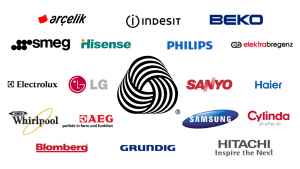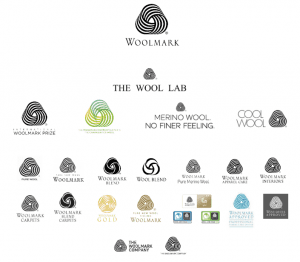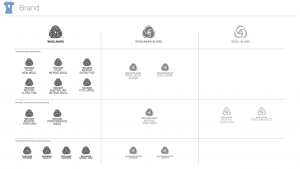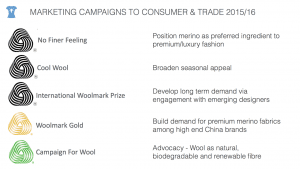AUSTRALIA’S iconic Woolmark has been cleaned up and is washing its way to financial success on behalf of the nation’s wool growers.
At a WoolPoll 2015 roadshow presentation at Casterton in south-west Victoria last Friday, Australian Wool Innovation chief executive officer Stuart McCullough said Woolmark licensing income will exceed the Federal Government’s matching research and development contribution to the wool industry within three years.
The Woolmark is the primary focus in AWI’s wool marketing strategies around the world, but also eight of the top 10 washing machine manufacturers use the Woolmark logo as the (wool) wash cycle, he said.
“They pay on a per washing machine basis, not a $7500 licence.
“The more washing machines they sell, the more money we get; good revenue to have, sticky money that — really sticky.”
With the wool levy paid by growers at 2 percent, the Federal Government’s unique R&D matching contribution amounted to about $13 million a year.
“The Woolmark licensing business creates about $10 million worth of revenue for you, for the company and we put that back into research and marketing.
“In the next three years the revenue that we get from licensing will outstrip what we get from the government,” Mr McCullough said.
“That is a good strip of revenue once it outstrips the government and we are planning to grow it.”
Woolmark rebranded with ‘Pure New Wool’
Mr McCullough said the branding and architecture of the Woolmark logo had been cleaned up over the last 12 months.
The original Woolmark logo in 1964 had the words “Pure New Wool under it, but “some marketing genius” put the word Woolmark under it in the 1980s, he said.
“He turned it from a mechanism that was advertising the fibre to a mechanism that was advertising a company – Woolmark — and I wanted to turn that back.
“I’ve turned that clock back and gone back to the words ‘Pure New Wool’ and I’ve done that because it is the essence of the brand, it advertises the fibre, not the company,” he said.
“I don’t want any more recognition for the company, I want recognition for your fibre.”
Mr McCullough believed that the new Woolmark will have some cachet with young consumers.
“We think that that young consumer – Gen Y – who has always heard about wool being itchy and scratchy, and dirty and the thing that your grandmother knitted, might go ‘Gee, there’s a new wool, there is something new in wool out there.
“So all the advertising will be focussed around ‘Pure New Wool’ from now on.”
Mr McCullough said before the logo was cleaned up, Woolmark’s brand architecture was “all over the shop“; in a range of colours, fonts and sizes.
“(There were) even some that I didn’t recognise.”
Woolmark use is growing again
Now, for the first time since 1996 the volume of licensees and the value of licensees is going up; it’s a significant amount of revenue, Mr McCullough said.
“And we doing that with pretty much zero effort – we are not knocking on doors begging people to buy licences.
“They are coming to us with cheques.”
Logo use and licensing income was growing because AWI was profiling the Woolmark logo.
“We are using it as our marketing mechanism in the Northern Hemisphere and they are seeing recognition and they saying “I want to put this on my garments, here’s a cheque, every year.”
Mr McCullough said the garment manufacturers only do what they are told by the retailers, who were requesting garments with the Woolmark logo, which meant it was recognised by consumers.
“When we are putting money into attracting consumers to it and advertising with it, the retailers are seeing a benefit and wanting it on.
“We are seeing on billboards, we are seeing it in newspapers, we are seeing it everywhere again,” he said.
“That’s a good news story — we think that this is a great logo.”
Rebranded and redesigned Woolmark logos are being used in all of AWI’s major marketing campaigns such as No Finer Feeling, Cool Wool, the International Woolmark Prize, Woolmark Gold and Campaign Wool.





Grace O’Donnell is quite correct when she says that “there are some brilliant hard working people at AWI who are passionate about wool………..”. However, that is not the issue; after wool growers investing billions of dollars in promotion over nearly 80 years, isn’t it time to ask if that investment has been successful? Even though wool is a wonderful manufacturing fibre, production of greasy wool and price continue to decline. It is my contention that the current system of promotion is flawed. A statutory tax on gross proceeds, creates a” honey pot”, politicises an industry, distorts direction and inevitably ends in failure. It is time for a major reassessment of promotion and to achieve this, I encourage all growers to vote for a zero tax. Anything less will only prolong the pain!
Promotion should not be done by a statutory organisation, but by commercial people with a nose for success!
Apologies Editor!
There are some brilliant hard working people at AWI who are passionate about wool, genuinely doing their best to promote and find solutions for our industry. When I read this article it’s hard to believe that Stuart McCullough is of the same ilk. Perhaps he is angling for departure? A genuine ‘leader’ of the industry would not undermine his team – I wonder how his chief marketing officer feels about his derogatory comment about “some marketing genius” and then to boast that “I’ve turned that clock back…” and “I’ve done that…” Really!? These are not the words of a true statesman, leader or team player. How embarrassing!
Full names required in future for reader comments please Grace, as per our long-standing comments policy: https://www.sheepcentral.com/about-us/sheep-central-comment-policy/ Editor
If Mr McCullough knew his industry history he would know that the Woolmark symbol with the words “pure new wool” were created by Bill Vines, managing director of the International Wool Secretariat (IWS) in the 1960’s. The symbol and the words were a result of Vines’ concern with an industry practice of that time of blending reconstituted wool, that is to say shredded wool from discarded woollen garments, with greasy wool to cheapen the product; thus the words “pure new wool”. I was present a grower’s meeting when Vines explained his strategy. Most consumers in the world today know that while the wool mark symbol is widely recognised, it does not denote quality, and the days of blending reconstituted wool are long gone! So while the whole world knows that the symbol has no value in respect to wool quality, we are going to make money now out of flogging the symbol as a cycle button on washing machines… Hasn’t anyone told you Mr McCullough that the great majority of people who buy wool knitwear today are in the upper educated, upper income group and hand wash? If you want evidence of this just look at the trend in consumption of knitting yarns that are treated for machine washing and those untreated. It would be much smarter Mr McCullough instead of aligning yourself with washing machine manufacturers that you used your energy and your position to explain to consumers some of the inherent characteristics of wool in respect to washing; such as how wool deflects dirt (unlike cotton and synthetics), therefore you can wear wool many times without the need to wash, how wool doesn’t absorb body odours, how soilage can be easily removed by a slight sponge and if the woollen garment has to be washed it dries in the air much faster than cottons. Wool therefore needs much less washing, uses less electricity and water in the home, therefore more environmentally friendly. There are many other consumer benefits to wool without having to prostitute the industry by flogging the Woolmark symbol on washing machines. If you want any evidence about the ability of wool to deflect dirt, ask stock agents for example who visit farmers. The farm dog is the first to jump up on the clean jeans for a friendly pat. If they are wearing wool denim jeans, (17 % wool), the dirty marks soon dry and are easily brushed off. With cotton jeans the soilage is retained and the washing machine is the only solution! It might be a mute point Mr McCullough, but seeing we are on the subject of wool denim jeans perhaps you could report to wool growers how the wool denim jean project is going with Levi and how many dollars of growers hard-earned income was expended on that project? It would also be interesting to see the evidence of your assertion at Casterton that consumers are asking for the Woolmark symbol. Obviously the Woolmark licensees have a motive for paying the $7500 wool mark license fee, but I wonder what it really is!